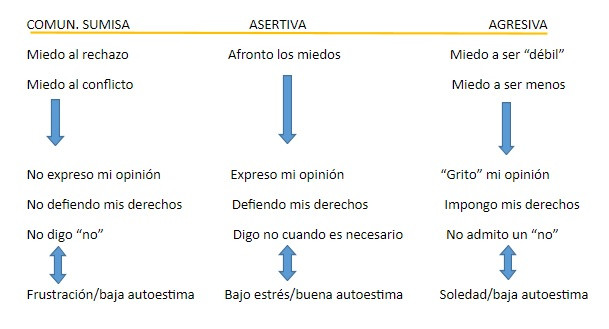
Assertiveness is the ability, which we can all develop, to express an opinion, desire or need without attacking others.
When we interact with others, there are many situations in which we have to say no, set limits or show disagreement. This requires the recognition of our emotions and their correct expression, without violating others. In this article we want to talk about the tools that help develop more assertive communication.
At Avance Psychologists we have observed that most of the time we hesitate more, when it comes to saying no to others, in situations in which we have to respond to someone aggressive, and when it comes to asking for favors, hence we want to focus on these. aspects and develop them, but not before understanding why it is difficult for us to be assertive and trying to find out How assertive are you?
The difficulties of being assertive
Sometimes we get the impression that saying “no” to someone can generate conflict or rejection from our interlocutor, and this is not necessarily the case. At other times, mistrust prevails, and we think that we have to defend ourselves against others and “put them in their place” almost constantly. This attitude generates many misunderstandings and the people around us avoid us for fear of feeling attacked or offended by us, which gives rise to a tense and stressful coexistence.
At Avance Psychologists we place special emphasis on this aspect during therapies, and we take care to give priority to developing this tool, since we are aware that good control of assertiveness is vital to reduce anxiety and improve self-esteem. The feeling of happiness and well-being increases significantly when our relationship with others stops being conflictive
The Assertiveness Continuum
Communication between people can be seen as a continuum at the center and balance of which is assertiveness. At both ends there are The ways of communicating that we should avoid: submissive communication and aggressive communication Before reaching these extremes there are degrees and nuances, but we are going to develop these concepts that can clarify which side of that continuum we are on.

When we engage in passive or submissive communication, we have real difficulties expressing our opinion or defending our rights. Saying “no” becomes a real trauma and it is very difficult for us to ask for favors. Fear of rejection and conflict They greatly influence us to stay on this side of the continuum. These fears are often determined by early experiences, in which we have received punishment or rejection for expressing ourselves. Sometimes dominant parents or experiences of rejection at school are behind submissive communication.
At the opposite extreme, Aggressive communication is based on the belief that others must be put in their place, that we must be distrustful in most cases and that we must impose ourselves to be strong, the opposite would mean weakness. This belief system, also normally built in early stages, leads to using raised and defensive tones of voice, disqualifications during conversation, and impositions.
At the center of the continuum is assertive communication, which is characterized by trying to express ourselves in different situations in a clear and non-aggressive way, trying to take others into account without forgetting ourselves. This is the most appropriate communication to understand ourselves with others, avoiding conflict, but facing our fears to express our opinions and express our rights. Achieving assertiveness is the starting point for developing good self-esteem
Many people are not at the extremes, in fact, most of us operate in intermediate degrees without reaching them, but even so, each of us has a certain tendency towards one side or the other. Furthermore, not in all areas of our lives we move on only one side of the continuum, We can be very assertive at work, but submissive with our partner and friends, or the other way around
Typically, the closer we get to the end of the continuum in one area of our life, the more we will need to compensate by jumping to the other. This explains those situations of “I hold on, I hold on and in the end I explode with those who least deserve it and at the most unexpected moment.”
Hence the importance of getting closer to assertiveness in all of them, to improve our relationships and have a greater sense of control of our emotions. This greatly influences self-esteem and the reduction of anxiety.
Tools to be more assertive
Next, we are going to delve into the aspects in which it is most difficult for us to be assertive, giving concrete tools for assertiveness
Saying “no” is probably one of the hardest responses we have to give to others. Many people accumulate large doses of stress due to the inability to say no and the need to please. But if we know how to do it and we also understand that others are not going to stop “loving us,” nor are they going to get angry because we say no, it will be much easier for us to begin to manage this response in our communication with others.
The first thing is express no, without hesitation too much If you don’t do it this way, you will end up being ambiguous and, yes, you can generate distrust.
In second place, you give an explanation so that the other does not feel rejected
And thirdly and finally, you give an alternative only in case you consider that the other person deserves it, you want and you can. This point is important to avoid establishing relationships in which there is an imbalance between who gives and receives, since over time they generate stress and resentment.
Some examples:
“I won’t be able to help you, I’m busy that weekend. If you want, we can leave it for the next person” (when we consider that the other person deserves an alternative, as long as we want and can).
“I won’t be able to help you, I’m busy that weekend” (when we consider that we don’t want to give the other an alternative, either because we can’t or because they don’t deserve it).
How to stay assertive when faced with someone aggressive
Being assertive with someone aggressive is especially useful, although also more complicated, since the other’s response is less predictable Even so, it is worth knowing how to be assertive on these occasions and having the peace of mind that your intention has been, at all times, to move with respect, regardless of how the other person chooses to react.
Next, we go on to describe some of the tools that we can use when the other is more upset or aggressive:
1. Extinction
Extinguishing the other’s response refers to respond without reinforcement, changing the subject or leaving the conversation, trying to use a friendly tone so that the other does not feel ignored.
Two examples of this would be: “I understand…, well… I’ll leave you because I have a lot to do now”, “it’s clear that we don’t think alike and we don’t have to convince the other, what do you think if we don’t give it more importance and leave this conversation?” for when we are calmer”
2. Ask us to specify
The aggressive person has a special tendency to generate insecurity in the other through accusation or emotional blackmail, but most of the time it is done vaguely and without specifying. For this reason, it is important to ask him to clarify for us, so that we have the opportunity to defend ourselves more fairly. Example: “I don’t understand what you mean by not doing my job, can you tell me what job you are referring to exactly, about what specific aspect of the project carried out so far, are you dissatisfied?
3. Fog bank
With this tool, we try to lower the tension by putting ourselves in the other’s place and recognizing their part of reason, but defending our point of view. Example: “I know you are telling me this with your best intentions, and I recognize that sometimes it is difficult for me to work as fast as you, but I think that at my own pace I do it well and that I try to do a good job.”
4. Scratched record
When someone wants to get something from us, and insists without paying attention to our “no”, being invasive, this tool is recommended, which consists of neither more nor less than repeating our message in a tone of respect, but immovable. Example of this: “I thank you for the proposal, but it doesn’t suit me to go on a hike this weekend (…), I understand your interest, but it really doesn’t suit me this weekend (…), yeah, yeah, but “The excursion plan this weekend doesn’t suit me.”
5. Mirror
Sometimes It may be convenient to let the other person see that you are getting too upset or that he is disrespecting us. Examples: “I think you are not aware of the tone you are using to talk to me”, “please, don’t shout, you can tell me the same thing, but in a different tone”.
How to make requests?
It is common to find people who find it especially difficult to ask favors from others, either because they fear annoying or being reckless, or because they are afraid of a “no”, or because their self-demand makes them fear appearing vulnerable. Behind this difficulty there is usually a fear of appearing weak, with the belief that “one has to be able to do everything.”
In these cases it is about expressing what we need, aware that we have the right to ask and the other to say no, but we must assume the risk of a “no”, and understand that this does not mean that the other is rejecting us. Examples: “I’m going to need your help, will you give me a hand when you can?”, “I love your dress, would you lend it to me someday?”
Empathize by asking
We can always express our need without the other feeling obligated, showing our empathy without ignoring our need. An example of this would be: “I know you are very busy, but could you give me a hand when you finish? I understand that now is not the time, but for me it is important that we talk about this when you have rested.”
Getting angry with assertiveness
Anger is a common and even necessary emotion a, since it provides us with the need to separate ourselves from the environment at certain times, or to set limits for others when necessary. Many people fear getting angry and hold it in because they fear rejection from others or because they believe that getting angry means being aggressive. Nothing to see! We can get angry, and very forcefully, without the other feeling attacked.
Subjective assertiveness
This tool consists of expressing feelings, making the other see that we put ourselves in their place, thus reducing tension but making our need very clear.
Examples: “The truth is that I am very hurt by the tone with which you spoke to me, I understand that we are both very nervous, but I do not want you to speak to me in that tone again”, “I am very angry right now, no You told me that you were not going to come and I have been waiting for you for more than an hour; “I can understand that you were in a lot of trouble and forgot to tell me, but now I don’t want to continue talking, I need to be alone.”
With this way of communicating our displeasure, the other can understand what is happening to us and also will be aware of what we need on future occasions
Getting angry assertively does not consist of shouting or making a bad face to generate effect, quite the contrary, the challenge is to control the tone and, from a calm perspective, express our emotions.








